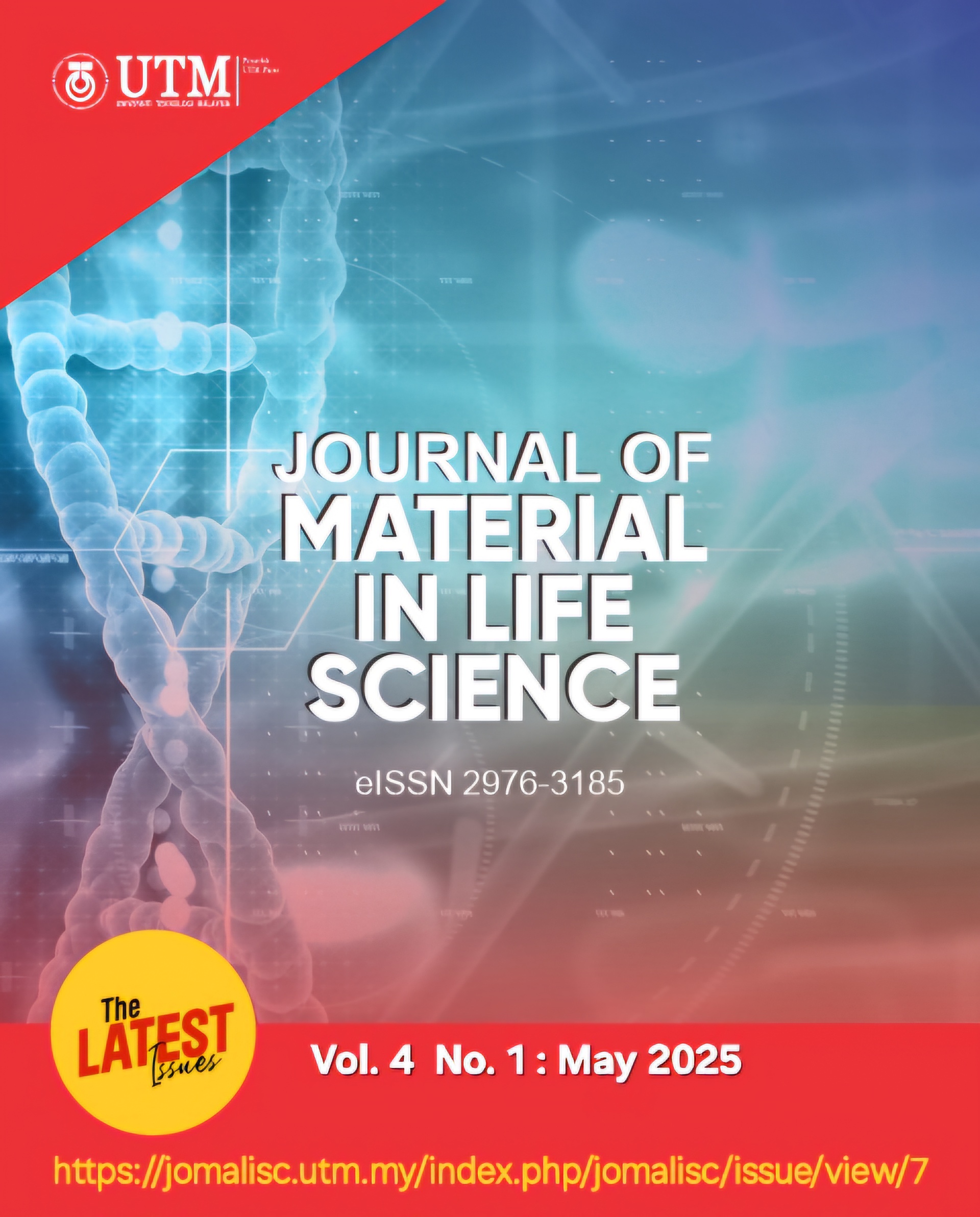Synthesis and Characterization of MIL-100(Fe) Metal-Organic Framework on Titania as Visible Light-Active Photocatalyst for Bisphenol A Degradation
DOI:
https://doi.org/10.11113/jomalisc.v4.84Keywords:
titania, metal-organic framework, photocatalysis, bisphenol AAbstract
Titania (TiO2) is a widely utilized metal oxide nanomaterial used for pollutant degradation, yet its limited activity under visible light restricts its broader photocatalytic applications. In this study, TiO2 was incorporated with a metal-organic framework, MIL-100(Fe), via the hydrothermal method forming MIL-100(Fe)/TiO2 composites. This study also investigated the impact of different amounts of TiO2 in MIL-100(Fe)/TiO2 composites. The structural and optical properties of the synthesized composites were characterized using various techniques. X-ray diffraction (XRD) confirmed the presence of both anatase and rutile TiO2 phases, while Fourier transform infrared (FTIR) spectroscopy validated the key functional groups. Ultraviolet-visible near-infrared (UV-Vis-NIR) spectroscopy revealed that MIL-100(Fe)/TiO2 composites with 5.4 mmol of TiO2 (MIL-100(Fe)/TiO2 (5.4)) exhibited a reduced bandgap of 1.70 eV, compared to 2.10 eV for MIL-100(Fe)/TiO2 composites with 1.8 mmol of TiO2 (MIL-100(Fe)/TiO2 (1.8)), enhancing visible-light absorption. Field emission scanning electron microscopy (FESEM) showed a size distribution of 74.7 – 99.1 nm. Photocatalytic activity of the synthesized MIL-100(Fe)/TiO2 composites was evaluated through bisphenol A (BPA) degradation under UV light irradiation initially. Notably, the synthesized MIL-100(Fe)/TiO2 (5.4) exhibited the highest photocatalytic activity (81.43%), while MIL-100(Fe)/TiO2 (1.8) showed the lowest efficiency (36.36%). Given the improved visible-light absorption from the reduced bandgap, further evaluation under visible-light conditions was conducted. The results revealed that MIL-100(Fe)/TiO2 (5.4) achieved significant degradation (69.49%), whereas commercial TiO2 exhibited no activity (0%). These findings confirm that MIL-100(Fe)/TiO2 composites enhance visible-light-driven photocatalysis by extending light absorption and improving charge separation, thereby reducing electron-hole recombination for effective environmental remediation.
References
Farooq, N., Kallem, P., ur Rehman, Z., Imran Khan, M., Kumar Gupta, R., Tahseen, T., Mushtaq, Z., Ejaz, N., & Shanableh, A. 2024. Recent trends of titania (TiO2) based materials: A review on synthetic approaches and potential applications. Journal of King Saud University - Science. 36(6): p. 103210.
Eddy, P., Md Auid-Orcid, Sakti, L. K., Sheha, Gan Auid-Orcid, Solihudin, Hidayat, S. Auid-Orcid, Takei, T. Auid-Orcid, Kumada, N., & Rahayu, I. 2023. Heterophase Polymorph of TiO2 (Anatase, Rutile, Brookite, TiO2 (B)) for Efficient Photocatalyst: Fabrication and Activity. Nanomaterials. (2079-4991 (Print)).
Thakur, N., Kumar, A., Thakur, V. K., Kalia, S., Arya, V., Kumar, A., Kumar, S., & Kyzas, G. Z. 2024. A critical review on the recent trends of photocatalytic, antibacterial, antioxidant and nanohybrid applications of anatase and rutile TiO2 nanoparticles. Science of The Total Environment. 914: p. 169815.
Zhou, H., Wang, H., Yue, C., He, L., Li, H., Zhang, H., Yang, S., & Ma, T. 2024. Photocatalytic degradation by TiO2-conjugated/coordination polymer heterojunction: Preparation, mechanisms, and prospects. Applied Catalysis B: Environment and Energy. 344: p. 123605.
Thoda, O., Moschovi, A. M., Sakkas, K. M., Polyzou, E., & Yakoumis, I. 2023. Highly Active under VIS Light M/TiO2 Photocatalysts Prepared by Single-Step Synthesis. Applied Sciences. 13.
Guo, J., Gan, W., Chen, R., Zhang, M., & Sun, Z. 2023. Au nanoparticle sensitized blue TiO2 nanorod arrays for efficient Gatifloxacin photodegradation. RSC Advances. 13(40): p. 28299-28306.
Sultana, M., Marzia, A., Islam, S., Khatun, M. A., Rahaman, M. H., Chakraborty, A. K., Rahman, M. S., Rahman, M. M., & Nur, A. S. M. 2023. Strategic development of metal doped TiO2 photocatalysts for enhanced dye degradation activity under UV–Vis irradiation: A review. Current Research in Green and Sustainable Chemistry. 7: p. 100383.
Geldasa, F. T., Kebede, M. A., Hone, F. G., & Jira, E. T. 2024. Influence of non-metals doping on the structural, electronic, optical, and photocatalytic properties of rutile TiO2 based on density functional theory computations. Computational Condensed Matter. 41: p. e00970.
Fard, N. E., Ali, N. S., Saady, N. M. C., Albayati, T. M., Salih, I. K., Zendehboudi, S., Harharah, H. N., & Harharah, R. H. 2024. A review on development and modification strategies of MOFs Z-scheme heterojunction for photocatalytic wastewater treatment, water splitting, and DFT calculations. (2405-8440 (Print)).
Zhu, Y., Zhou, S., Zhu, J., Wang, P., Wang, X., Jia, X., Wågberg, T., & Hu, G. 2022. Mesoporous carbon decorated with MIL-100(Fe) as an electrochemical platform for ultrasensitive determination of trace cadmium and lead ions in surface water. Ecotoxicology and Environmental Safety. 243: p. 113987.
Hejazi, R., Mahjoub, A. R., Khavar, A. H. C., & Khazaee, Z. 2020. Fabrication of novel type visible-light-driven TiO2@MIL-100 (Fe) microspheres with high photocatalytic performance for removal of organic pollutants. Journal of Photochemistry and Photobiology A: Chemistry. 400: p. 112644.
Channab, B.-E., El Ouardi, M., Ait Layachi, O., Marrane, S. E., El Idrissi, A., BaQais, A., & Ait Ahsaine, H. 2023. Recent trends on MIL-Fe metal–organic frameworks: synthesis approaches, structural insights, and applications in organic pollutant adsorption and photocatalytic degradation. Environmental Science: Nano. 10(11): p. 2957-2988.
Razia, S., T. Hadibarata, and S.Y. Lau. 2024. A review on biodegradation of Bisphenol A (BPA) with bacteria and fungi under laboratory conditions. International Biodeterioration & Biodegradation, 195: p. 105893.
Abu Hasan, H., Muhamad, M. H., Budi Kurniawan, S., Buhari, J., & Husain Abuzeyad, O. 2023. Managing Bisphenol A Contamination: Advances in Removal Technologies and Future Prospects. Water, 15.
Wardhani, S., Purwonugroho, D., Fitri, C. W., & Prananto, Y. P. 2018. Effect of pH and irradiation time on TiO2-chitosan activity for phenol photo-degradation.
Sadek, O., Touhtouh, S., Rkhis, M., & Hajjaji, A. 2024. Study of the hydroxylation of the TiO2 thin layer prepared by spin-coating method using FTIR analysis and DFT theory. Inorganic Chemistry Communications. 161: p. 112092.
Hwang, J. Y., Moon, G., Kim, B., Tachikawa, T., Majima, T., Hong, S., Cho, K., Kim, W., & Choi, W. 2021. Crystal phase-dependent generation of mobile OH radicals on TiO2: Revisiting the photocatalytic oxidation mechanism of anatase and rutile. Applied Catalysis B Environment and Energy, 286, 119905.
Nehra, M., Dilbaghi, N., Singhal, N. K., Hassan, A. A., Kim, K.-H., & Kumar, S. 2019. Metal organic frameworks MIL-100(Fe) as an efficient adsorptive material for phosphate management. Environmental Research. 169: p. 229-236.
Lomba-Fernández, B., Fdez-Sanromán, A., Pazos, M., Sanromán, M. A., & Rosales, E. 2024. Iron metal-organic framework nanofiber membrane for the integration of electro-Fenton and effective continuous treatment of pharmaceuticals in water. Chemosphere. 366: p. 143447.
Wu, W., Zhu, J., Deng, Y., Xiang, Y., Tan, Y., Tang, H., Zou, H., Xu, Y., & Zhou, Y. 2019. TiO2 nanocrystals with the {001} and {101} facets co-exposed with MIL-100(Fe): an egg-like composite nanomaterial for efficient visible light-driven photocatalysis. RSC Advances. 9: p. 31728-31734.
Sheraz, M. and J. Kim. 2024. Reusable MIL-100(Fe)-polyacrylonitrile-TiO2 nanofiber webs for adsorption and decomposition of toluene. Chemical Engineering Journal. 496: p. 153542.
Huang, C.-W., S.-R. Zhou, and W.-C. Hsiao. 2024. Multifunctional TiO2/MIL-100(Fe) to conduct adsorption, photocatalytic, and heterogeneous photo-Fenton reactions for removing organic dyes. Journal of the Taiwan Institute of Chemical Engineers. 158: p. 104850.
Guesh, K., Caiuby, C. A. D., Mayoral, Á., Díaz-García, M., Díaz, I., & Sanchez-Sanchez, M. 2017. Sustainable Preparation of MIL-100(Fe) and Its Photocatalytic Behavior in the Degradation of Methyl Orange in Water. Crystal Growth & Design. 17(4): p. 1806-1813.
Janczarek, M., Klapiszewski, Ł., Jędrzejczak, P., Klapiszewska, I., Ślosarczyk, A., & Jesionowski, T. 2022. Progress of functionalized TiO2-based nanomaterials in the construction industry: A comprehensive review. Chemical Engineering Journal. 430: p. 132062.
Elharony, N., Sayed, I., Al-sehemi, A., Al-Ghamdi, A., & Abou Elyazed, A. 2021. Facile Synthesis of Iron-Based MOFs MIL-100(Fe) as Heterogeneous Catalyst in Kabachnick Reaction. Catalysts. 11: p. 1451.
Erdman, N., D.C. Bell, and R. Reichelt. 2019. Scanning Electron Microscopy, in Springer Handbook of Microscopy, P.W. Hawkes and J.C.H. Spence, Editors. Springer International Publishing: Cham. p. 229-318.
Li, L., Xu, S., Liu, Z., & Wang, D. 2024. Insight into the Growth Mechanism of Low-Temperature Synthesis of High-Purity Lithium Slag-Based Zeolite A. Materials. 17.
Belekoukia, M., Tan, J., Andresen, J., Wang, H., Maroto-Valer, M., & Xuan, J. 2019. Laser Induced Plasmonic Heating with Au Decorated TiO2 Nanoparticles. Energy Procedia. 158: p. 5647-5652.
Al-Baradi, A. M., Al-Shehri, S. F., Badawi, A., Merazga, A., & Atta, A. A. 2018. A study of optical, mechanical and electrical properties of poly(methacrylic acid)/TiO2 nanocomposite. Results in Physics. 9: p. 879-885.
Ghosh, S., Pourebrahimi, S., Malloum, A., Ajala, O. J., AlKafaas, S. S., Onyeaka, H., Nnaji, N. D., Oroke, A., Bornman, C., Christian, O., Ahmadi, S., & Wani, M. Y. 2023. A review on ciprofloxacin removal from wastewater as a pharmaceutical contaminant: Covering adsorption to advanced oxidation processes to computational studies. Materials Today Communications. 37: p. 107500.
He, X., Fang, H., Gosztola, D. J., Jiang, Z., Jena, P., & Wang, W.-N. 2019, Mechanistic Insight into Photocatalytic Pathways of MIL-100(Fe)/TiO2 Composites. ACS Applied Materials & Interfaces. 11(13): p. 12516-12524.
Le, T.M. and T.D. Nguyen. 2024. Enhancement of visible-light photocatalysis of TiO2 via nanocomposite incorporating with Fe(III) species. Results in Engineering. 23: p. 102500.
Yi, H., Jiang, M., Huang, D., Zeng, G., Lai, C., Qin, L., Zhou, C., Li, B., Liu, X., Cheng, M., Xue, W., Xu, P., & Zhang, C. 2018. Advanced photocatalytic Fenton-like process over biomimetic hemin-Bi2WO6 with enhanced pH. Journal of the Taiwan Institute of Chemical Engineers. 93: p. 184-192.
Wei, Y., Fu, Z., Meng, Y., Li, C., Yin, F., Wang, X., Zhang, C., Guo, L., & Sun, S. 2024. Photocatalytic degradation of methylene blue over MIL-100(Fe)/GO composites: a performance and kinetic study. International Journal of Coal Science & Technology. 11(1): p. 42.
Rosa, D., G. Manetta, and L. Di Palma. 2024. Experimental assessment of the pH effect and ions on the photocatalytic activity of iron-doped titanium dioxide supported on polystyrene pellets: Batch and continuous tests. Chemical Engineering Science. 291: p. 119918.
Lee, H., Lee, H., Ahn, S., & Kim, J. 2022. MIL-100(Fe)-Hybridized Nanofibers for Adsorption and Visible Light Photocatalytic Degradation of Water Pollutants: Experimental and DFT Approach. ACS Omega. 7(24): p. 21145-21155.
Nasikhudin, Diantoro, M., Kusumaatmaja, A., & Triyana, K. 2018. Study on Photocatalytic Properties of TiO2 Nanoparticle in various pH condition. Journal of Physics: Conference Series. 1011(1): p. 012069.
Kisała, J., Hörner, G., Barylyak, A., Pogocki, D., & Bobitski, Y. 2022. Photocatalytic Degradation of 4,4'-Isopropylidenebis(2,6-dibromophenol) on Sulfur-Doped Nano TiO2.


















